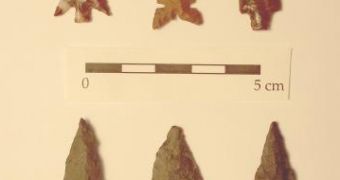People don't give much thought today to the trials and error experiments that led us to the current technological advancement, but it looks as if humans were masters in such experimentation especially at the time when the bow and arrow first appeared and started to be used for hunting and fighting. The variety of projectile points found and dated around that time show that humans had first started perfecting these weapons by experimental research, in order to create the most effective system.
"Technological innovation and change has become a topic that interests people. When the bow and arrow appeared in North America, roughly 1,500 years ago, it eventually replaced the atlatl (spear thrower) and dart. The introduction of the bow and arrow, a different weapon delivery system, demanded some innovative thinking and technology. In other words, one could not just shoot a dart from a bow. Components like the shaft and arrow point needed to be reinvented", said R. Lee Lyman professor and chair of the Department of Anthropology at the University of Missouri.
Notions such as flight dynamics and mechanics were far from being understood at that time, thus the experiment was the best way to learn and discover the optimal system. This process can be easily seen in the increase of variations and numbers of projectile points, which is associated with the transition from the spear thrower to the bow and arrow.
"Everyone is looking for the better mouse trap. Once a change is made in one variable, it may prompt changes in another variable because the two are mechanically linked. For example, if something gets longer, generally, it will get heavier. This is called a cascade effect. This, in combination with experimentation, resulted in the tremendous variation in projectile points", Lyman said.
The variation and numbers of projectile points peak exactly at the time when the transition began. As soon as the experimental phase was over, the most efficient projectiles remained while the other had been discarded, accounting for the decrease in model variations discovered by archaeologists following this period. The study was based on data regarding more than 1,000 projectile models found in three geographical areas of the globe.

 14 DAY TRIAL //
14 DAY TRIAL //